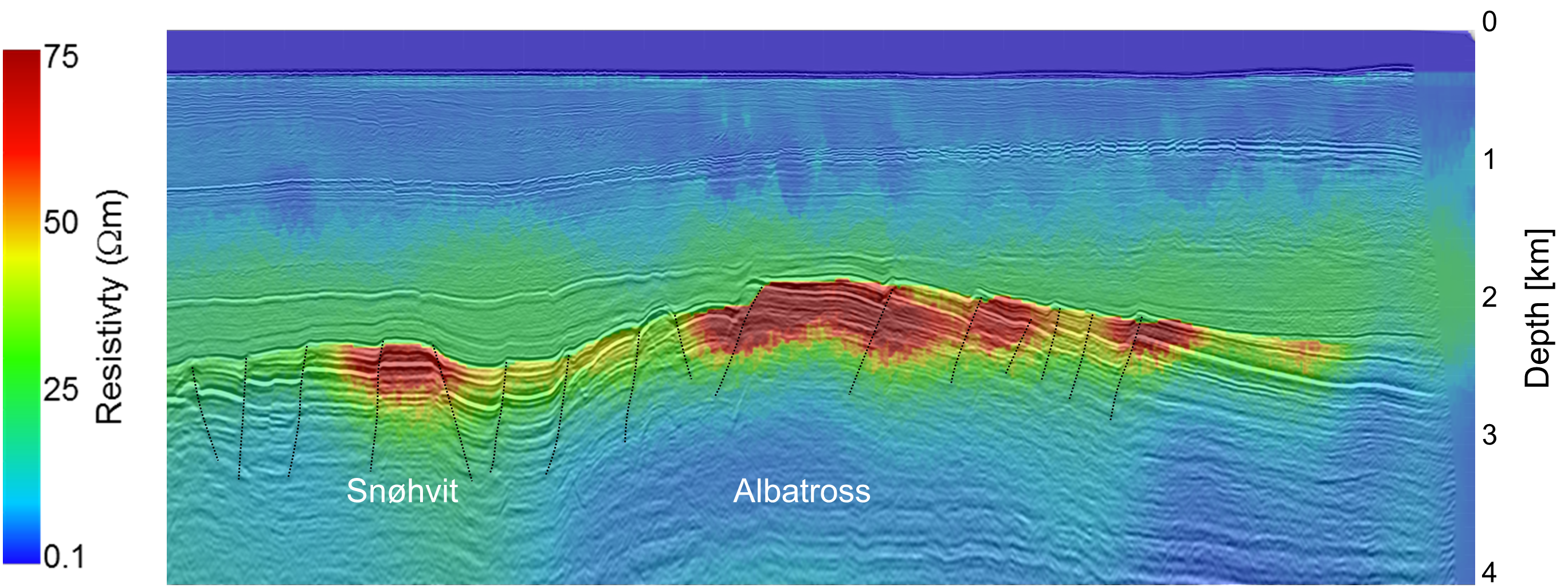What is the meaning of efficiency? One interpretation is simply to achieve more for a lower outlay; this theme has been synonymous with PGS’ towed-streamer electromagnetic (EM) technology from concept to commercialization.
Acquisition efficiency
Three-dimensional towed-streamer EM acquisition rates of up to 250 sq km (96 sq miles) per day have been achieved in the Barents Sea, with average daily production in 2014 on a large 3-D EM project on the order of 120 sq km (46 sq miles) per day with 1-km (.62-mile) line spacing. To ensure maximum efficiency when acquiring data, the system was designed to be deployed from the same vessel as a GeoStreamer. This enables the acquisition of both dual-sensor broadband seismic and high-density towed-streamer EM data simultaneously.
Data density
To accurately invert controlled-source EM (CSEM) data, it is essential to have a high-density dataset to commence the inversion process, especially to achieve high-resolution, accurate models of the subsurface resistivity. PGS seeks to ensure efficient acquisition of high-density EM data by employing a shot cycle every 120 seconds and recording 72 individual offsets in the EM streamer. This EM shot cycle equates to one shot every 250 m (820 ft) when acquiring data at 4 knots. By combining the 72 receiver offsets with the 250-m shot spacing, PGS achieves high data density on both the source and receiver sides.
The improvement in overall subsurface understanding, risk mitigation and inversion resolution gained from simultaneously acquiring high-density towed-streamer EM with GeoStreamer broadband seismic is demonstrated in Figure 1. PGS used a single seismically interpreted horizon to guide a 2.5-D inversion. The results are clear: The higher the data density, the more accurate the recovery of the subsurface resistivity, especially at depth.
Broadband seismic, EM data integration
To improve the resolution of the EM data, seismic horizons (or other geophysical data) can be used to guide the inversion (Figure 1). While guided inversion can improve the resolution, unconstrained inversion remains a high-value product, especially when interpreted in conjunction with GeoStreamer data. Seismically guided anisotropic 2.5-D inversion of towed-streamer EM data can improve the lateral and vertical resolution of resistivity anomalies, adding further value to the complementary seismic and EM data through integration of the two.
PGS is developing an integrated workflow that uses seismic, well log and towed-streamer EM data to estimate totalydrocarbon volume in place. Work is ongoing on this project, and PGS anticipates publishing a detailed paper soon.
When acquired, interpreted and integrated with seismic, maximum value can be extracted from towed-streamer CSEM data. This makes it a cost-effective method to de-risk frontier areas, improve well location decisions, provide drilling hazard identification and monitor changes in gas saturation. The key differentiators of towed-streamer EM are acquisition efficiency and the increase provided in data density, resulting in cost-effective and accurate mapping of subsurface resistivity.

Recommended Reading
Oxy’s Stratos Direct Air Capture Project Nears Finish Line
2025-02-20 - Stratos Phase 1 is 94% complete overall and 98% complete on construction, Occidental Petroleum says.
California Resources Continues to Curb Emissions, This Time Using CCS for Cement
2025-03-04 - California Resources’ carbon management business Carbon TerraVault plans to break ground on its first CCS project in second-quarter 2025.
BKV Reaches FID, Forms Midstream Partnership for Eagle Ford CCS Project
2025-02-13 - If all required permits are secured, BKV’s CCS project in the Eagle Ford Shale will begin full operations in first-quarter 2026, the Barnett natural gas producer says.
CF Industries Form JV to Build $4B Low-Carbon Ammonia Project in Louisiana
2025-04-08 - CF Industries has reached a FID with JERA and Mitsui for an ammonia production facility in Louisiana. CF Industries sealed a deal with Occidental’s 1PointFive to capture and store CO2 from the facility.
Cella Mixes Two Approaches to Keep CO2 Solidly Underground
2025-04-01 - Cella, a startup in partnership with Halliburton, injects CO2 into basaltic reservoirs, where it reacts and hardens.
Comments
Add new comment
This conversation is moderated according to Hart Energy community rules. Please read the rules before joining the discussion. If you’re experiencing any technical problems, please contact our customer care team.





